Table of Contents
Understanding Searcher Behavior & Search Ranking Factors
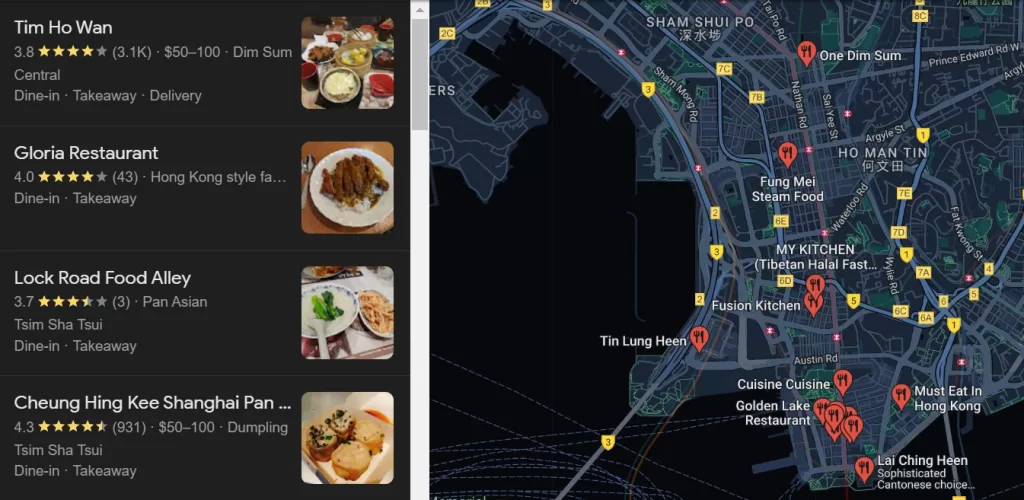
Optimizing a website or a Google Business profile is a little different for industries like restaurants compared to other industries.
For a roofing or plumbing company, users will likely be looking for a webpage and results from the Google Map Pack (image above).
For users looking for restaurants to eat, they probably won’t be looking for a webpage. So, the general strategy here is to rank for the local map pack.
This means that restaurants usually don’t need a website to do well in the map packs, despite it being a direct ranking factor.
We also have to take a look at user behavior and what stage of the funnel they are in. Let’s take a look at some examples of keywords and funnel indications:
- Top of the search funnel: Generally people at the top of the search funnel don’t know the type of food they want to eat, so searches will be pretty generic, like “food in [your location]”. The conversion rate for these keywords is lower since users are undecided while being the hardest to rank.
- Middle of the search funnel: Users at this stage usually have a better idea of what they want, so searches are more specific and niched down. Think of keywords like “Chinese food near me” or “Indian food in [your location”. The conversion rate is also higher while being easier to rank.
- Bottom of the search funnel: Searchers at the bottom of the search funnel know what they want and are directly looking to order food or go to a restaurant. At this stage, people will be searching for the types of foods within a certain cuisine, like “Shawarma spots near me”, or branded keywords like “Mike’s Deli”.
Now that you have some context regarding the user journey, it’ll be easier to understand why the tips that we’ll give later will help your Google Business Profile succeed!
How to Optimize Your Restaurant’s Google Business Profile - The Right Way!
Make Sure Your Restaurant’s Category Best Suit Your Restaurant
When selecting your restaurant category, you have to pick the best one that describes you. Many people
Other than that, you should ideally do some keyword research to determine whether your category is a popular term or not.
For example, “Chinese Food in NYC” is going to be a popular term, but terms like “Colombian Fusion Food in Denver” might be something that is not searched for often.
As a result, we recommend doing some simple keyword research to make sure that your specialty has adequate search volume.
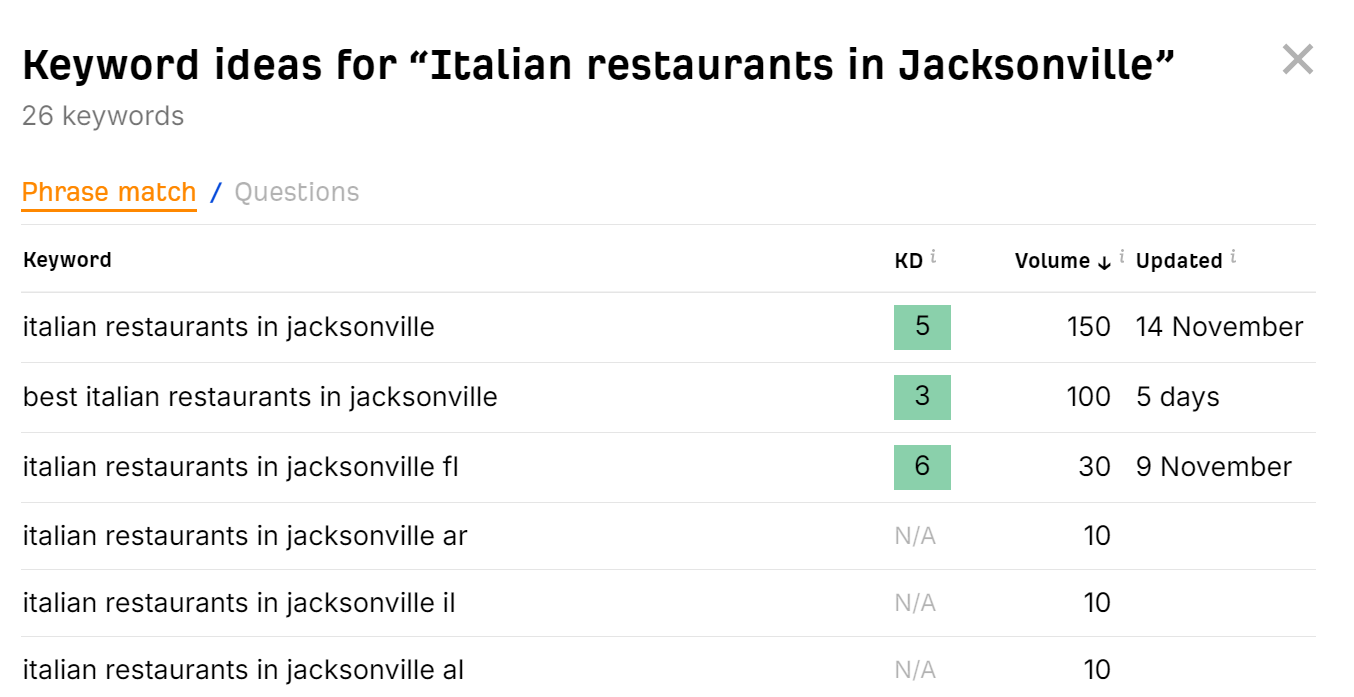
Here’s a simple and free way to do keyword research for restaurants:
- Go to Ahref’s Free Keyword Explorer Tool.
- Ensure you’re on the “Google” section and set it to your specific country.
- Enter your chosen keyword phrase, such as “Italian restaurants in Jacksonville”.
- You will then be presented with different variations of your keywords.
- Apply filters for (Keyword Difficulty) and Volume. A higher KD value indicates that it’s harder for your restaurant to rank. Volume indicates the monthly search frequency for that keyword.
- We’d recommend going with the option that has a KD of less than 10, and a volume of at least 150 when you’re first starting.
- Select the ideal keyword that strikes a balance between low difficulty and a substantial search volume. In this scenario, “Italian Restaurant in Jacksonville” emerges as the optimal choice due to its significant search volume paired with relatively low difficulty.
You can also use this method to look for bottom-funnel keywords, just do the same for the food type + your location.
For example, terms like “Chinese Dumplings in the Bay Area”, might be a good keyword to include in your restaurant’s description and menu listing – both of which we’ll talk about later.
Give a Complete & Detailed Restaurant Description

A complete and detailed restaurant description needs to be both engaging and informative.
This not only lets Google know what your restaurant is and what type of food you’re serving up but also entices the reader into wanting to try your restaurant out or book a reservation.
Here is a checklist of good practices that you can implement for your product description:
- Mention the area that you serve.
- Include any relevant keywords from your keyword research.
- Talk about any awards or mentions for social proofing.
- Mention a couple of popular dishes that you serve (preferably through keyword research).
- Include anything that could make your restaurant stand out, like any charitable contributions or events that you host.
Add Your Menu Items With Good Pictures
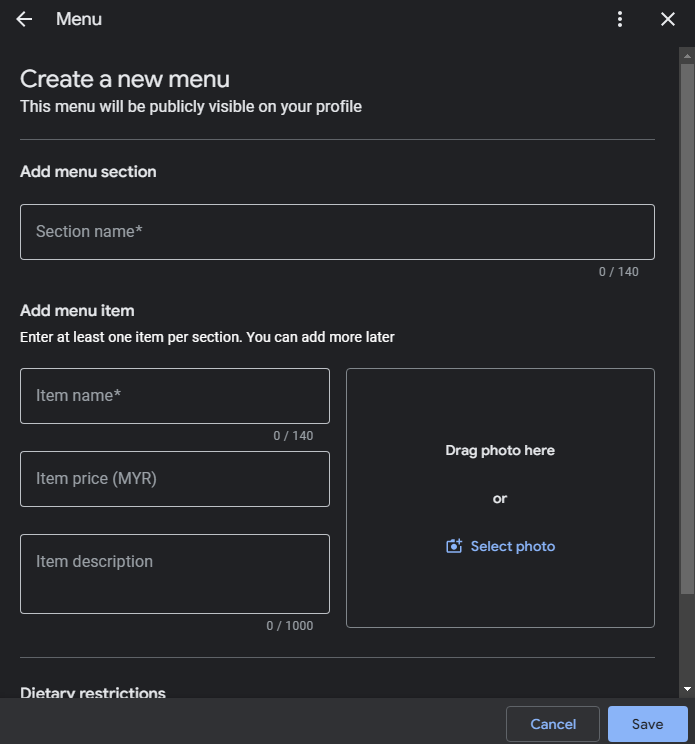
Adding menu items to your Google Business Profile is a good way for Google to pick up on the type of food that you’re serving. Aside from having photos of your menu, you should also aim to add each menu item as a product category.
If you take a look at the sample above, you can see that this restaurant’s Google Business Profile has individual items listed, alongside pictures that can help rank for bottom-funnel keywords.
Here’s a step-by-step guide on how you can add your restaurant’s menu items to your Google Business Profile:
- Log in to your Google Business Profile.
- Click on “Edit Menu”.
- Under “Full Menu”, click “Create a Menu”.
- List all the information of the food item, including the item name, description, and a good photo!
- You should also take a photo of your physical menu and upload it for visibility. You can find it under “Photos of Menu”.
Operating Hours Should be Accurate At All Times
It’s common knowledge that the hours that you list on your Google Business Profile should be accurate to your actual opening hours right?
Well, yes and no. Did you know that many businesses used to put ‘Open 24-hours’ to get the edge on the competition?
As of November 2023, openness is a direct ranking factor for local search, according to Search Engine Journal. This means that it’s more important than ever for you to list the proper operating hours of your restaurants.
On top of that, we’d also recommend adding special hours during public holidays, to provide a better user experience, and in turn, a better chance to rank for your desired keywords.
Ensure That Your NAP is Consistent & Accurate Everywhere
In local search, your NAP (Name, Address, Phone Number) is one of the most important things that you need to get right.
The general idea is that having it consistent makes sure you make it as easy as possible for Google’s crawlers to create connections between your business, social media, directories, and mentions.
So, make sure your NAP is accurate and consistent, word-for-word across all your platforms and listings. So, if you use ‘Street’, keep it consistent and avoid ‘St.’. The same goes for ‘Blvd’, and ‘Boulevard’.
We’d also recommend having your address and phone number at the footer of your website for the best user experience.
On top of that, having a locations page is also paramount when optimizing for local search, especially if you have more than one location.
You should also include a Google Maps plugin in your locations page. This makes it easy for users as well as Google’s crawlers to know that you’re a legitimate business serving customers.
You can do this using a WordPress plugin, or through Google’s official implementation method.
Maximize the Use of CTA Features
Another important thing to optimize that most restaurants neglect is to maximize the use of CTA (call-to-action) features.
If you’re unfamiliar with what a CTA is, it’s a convenient button or link on your Google Business Profile that users can click after visiting your profile to take action.
It can be a link that brings them to an online ordering platform or maybe a booking engine that allows them to book an appointment.

You can have more than one link or button, as illustrated in the image above. On top of user experience, this is the primary way to get customers to take action and increase conversion.
No point in ranking number 1 if customers find it hard to get directions, book appointments, or even order online. Plus, user experience is a ranking factor.
If people ‘bounce’ on your page, it sends a signal to Google that your page might not be deserving of the number 1 spot.
If you’re interested in maximizing conversion and user experience, we at KlikNRoll offer a complete online booking solution that is designed to convert searchers to customers.
On a side note, we can make a custom online delivery platform for you, just in case you’d like to have more call-to-actions! Plus, you don’t have to pay up to 30% in commissions for certain platforms.
Click the button below to learn more!
Encourage Descriptive Reviews & Respond to Each One
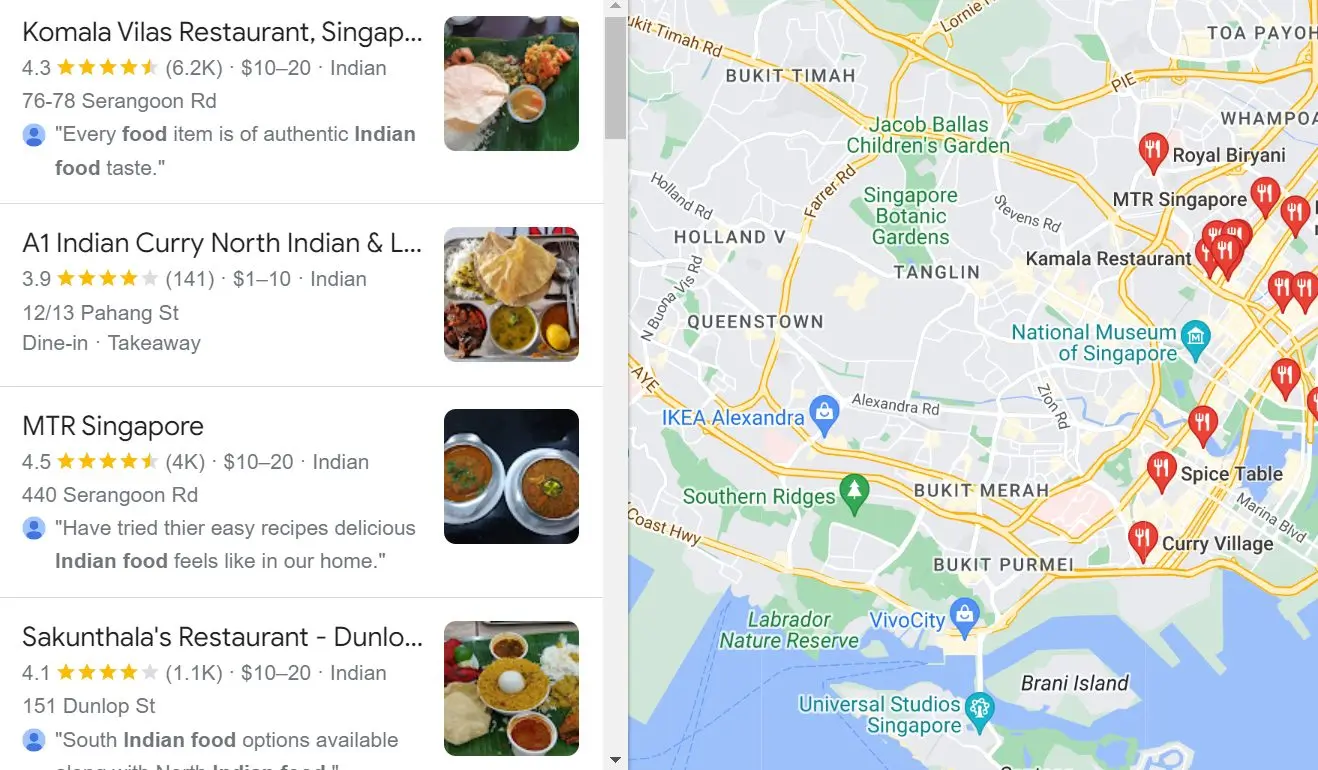
Reviews are the bread and butter of any business, especially restaurants – and it helps if the reviews you get are descriptive and come with pictures. This holds more weight compared to regular reviews with no context.
Google’s algorithm is also very smart in detecting reviews, so don’t buy reviews – no matter how tempting it is. There have been cases where entire Google Business Profiles are suspended as a result, so think long-term!
Tip: A good way to get more reviews is to compensate diners in exchange for a review. If that is not feasible, you can try gamifying the experience. Make it fun for customers! It could be a raffle ticket or something as simple as post-meal discounts.
According to our own research, top-ranking restaurants in big cities like New York or Hong Kong tend to have 1600 to 4700 reviews on Google. So, we’d recommend getting started ASAP!
You should also reply to every review, positive or negative. This lets search engines know that you are giving customers the best experience, are active, and care about what customers think. As a result, your rankings can improve!
Try Out Google Business Profile’s Post Feature
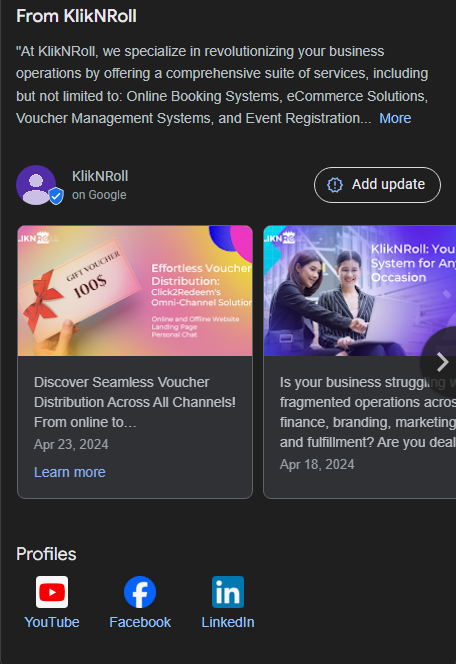
In line with letting people and Google know that you’re active, you should try out Google Business Profile’s post/update features.
In this section, you should talk about any events or promotions that you might be having. Not only is it user-friendly, but Google might use these to showcase your listing for queries like “events in [your location]”.
It helps to be more specific and descriptive in your posts, like including the types of dishes that are on promotion, etc. This helps Google understand your post and might feature you more prominently for bottom-funnel keywords!
Generally, you should aim to post these 2 to 4 times a month – but don’t force it if you don’t have anything special to post!
The Bottom Line
There you have it, everything you need to know in order to optimize your Google Business Profile. If you’re interested in a more holistic organic search strategy, you can check out our full restaurant search engine optimization (SEO) guide to learn more!

Hey there! I’m Jeffrey Hau, and my journey in the digital world started after I wrapped up my psychology degree at UCLA. Imagine coming back to the bustling streets of Hong Kong from the tech haven of Silicon Valley – it was a whirlwind of inspiration! Seeing how social media platforms were evolving at breakneck speed and realizing the limitations of traditional advertising in this digital age, I decided to dive in.
In 2012, I laid the foundation of Prizm Group. From our humble beginnings, we’ve now blossomed into a global powerhouse with a team of over 200 passionate professionals. Our HQ is right here in Hong Kong, and we’ve spread our wings to SG, AU, NZ, JP, and China.
As a digital problem solver, our team found that several industries are in need of reservation systems, especially for F&B, Hotels, Beauty, and Medical sectors. Our digital magicians started crafting reservation systems tailored to cater to these specific needs. We extended our expertise to e-commerce, voucher management systems, and campaign management systems, combining them into KlikNRoll – an all-in-one solution. We deep dive into various industries, understanding their unique challenges and developing innovative solutions.
We’re not just a company; we’re your dedicated partners in transforming how you navigate the digital landscape. Our passion lies in providing businesses with intuitive and tailored solutions using KlikNRoll’s powerful capabilities.
Ready to embark on this exciting digital adventure with us? Let’s make your brand stand out in the digital jungle!






